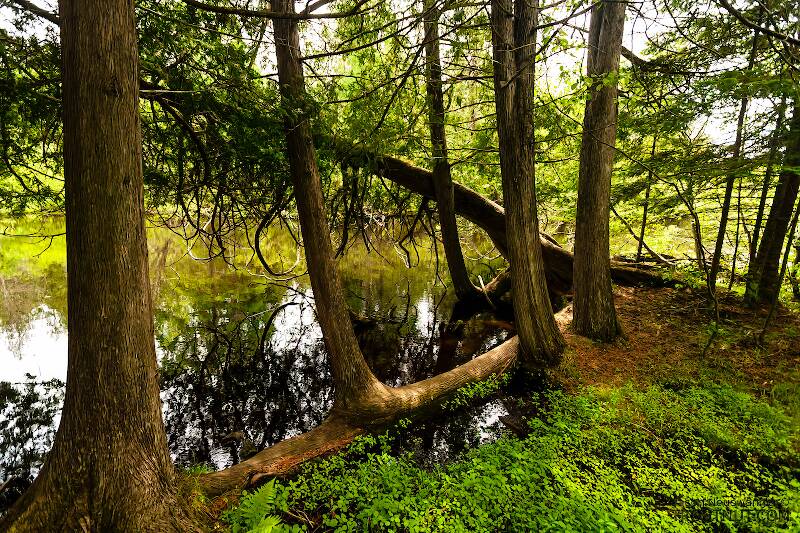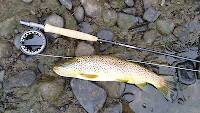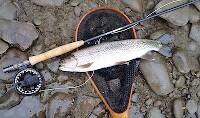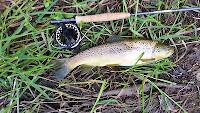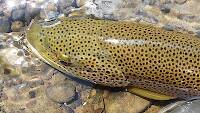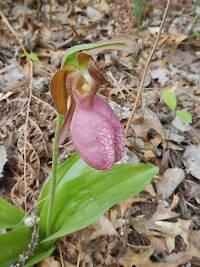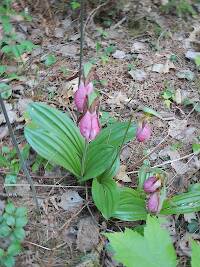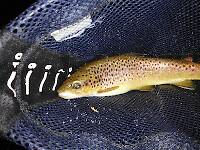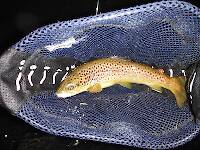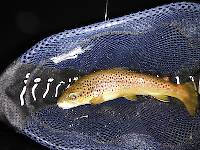
Salmonflies
Pteronarcys californica
The giant Salmonflies of the Western mountains are legendary for their proclivity to elicit consistent dry-fly action and ferocious strikes.
Featured on the forum

This one pretty clearly keys to Kogotus, but it also looks fairly different from specimens I caught in the same creek about a month later in the year. With only one species of the genus known in Washington, I'm not sure about the answer to this ID.

Troutnut is a project started in 2003 by salmonid ecologist Jason "Troutnut" Neuswanger to help anglers and
fly tyers unabashedly embrace the entomological side of the sport. Learn more about Troutnut or
support the project for an enhanced experience here.
Trowpa on Nov 10, 2008November 10th, 2008, 4:58 am EST
I know many of the regulars here (ok most) are much more scientific about their fishing than I am...so if I'm asking something that may be an obvious to you -humor me.
The stretch of stream behind my house used to have a mix...(fished there for the past 6 years). The last few weeks i've seen plenty of rainbows (and caught some too :) ) but not seen a single brown trout.
What could be possible reasons for a stretch of stream which used to have a good mix of rainbow/brown with an occasional brookie to go to almost exclusively rainbow? Should I be concerned about habitat/water quality? Is it due to temperatures? water level? time of year? that the fish would segregate themselves out of a particular stretch? Am i just not seeing the browns (could they be hiding while the rainbows are active?)
Main two changes i've noticed from the "norm" is the water is "gin clear" and very low.
Without more data i know a proper diagnosis isn't possible - just looking for info on possible reasons for this change...
Thanks
The stretch of stream behind my house used to have a mix...(fished there for the past 6 years). The last few weeks i've seen plenty of rainbows (and caught some too :) ) but not seen a single brown trout.
What could be possible reasons for a stretch of stream which used to have a good mix of rainbow/brown with an occasional brookie to go to almost exclusively rainbow? Should I be concerned about habitat/water quality? Is it due to temperatures? water level? time of year? that the fish would segregate themselves out of a particular stretch? Am i just not seeing the browns (could they be hiding while the rainbows are active?)
Main two changes i've noticed from the "norm" is the water is "gin clear" and very low.
Without more data i know a proper diagnosis isn't possible - just looking for info on possible reasons for this change...
Thanks
-Steve
LittleJ on Nov 10, 2008November 10th, 2008, 5:58 am EST
steve,
This is not a scientific comment, but if it has just been that you have seen this change in the past few weeks it could be that the rainbows are on the move to spawn(and have started). At least in the streams that I frequent the rainbows usually are on the move before the browns. The harvey project on spruce creek is a perfect example, throughout the year you will catch a good mix of fish, but with the first hint of fall those rainbows are on the move and that seems to be all you see. It could also be tied to the fact that rainbows seem to have much less trouble "exposing " themselves than do browns.
Jeff
This is not a scientific comment, but if it has just been that you have seen this change in the past few weeks it could be that the rainbows are on the move to spawn(and have started). At least in the streams that I frequent the rainbows usually are on the move before the browns. The harvey project on spruce creek is a perfect example, throughout the year you will catch a good mix of fish, but with the first hint of fall those rainbows are on the move and that seems to be all you see. It could also be tied to the fact that rainbows seem to have much less trouble "exposing " themselves than do browns.
Jeff
Troutnut on Nov 10, 2008November 10th, 2008, 7:53 am EST
I wouldn't read too much into a shift like that on the time scale of a few weeks. It could have something to do with seasonal movements or behavioral changes in either species.
If you've seen shifts in species composition over a longer time scale, that could be a sign of environmental changes, though there are some other explanations.
If you've seen shifts in species composition over a longer time scale, that could be a sign of environmental changes, though there are some other explanations.
Jason Neuswanger, Ph.D.
Troutnut and salmonid ecologist
Troutnut and salmonid ecologist
GONZO on Nov 10, 2008November 10th, 2008, 7:58 am EST
Am i just not seeing the browns (could they be hiding while the rainbows are active?)
I think that's probably it, Steve. With prolonged low and gin-clear water, I suspect that the brown's photophobic and cover-loving tendencies probably account for some of the difference. Rainbows generally seem more willing to feed in open water during the bright part of the day than browns, especially under clear-water conditions.
The other thing that comes to mind is that you might be seeing temporary fluctuations in recruitment. In a mixed trout population like the Little Lehigh's (not just mixed species, but mixed wild and stocked trout), diminishment of a couple of year-classes of wild trout might affect the proportions of rainbows to browns that you see. Browns make up the majority of the wild population, and a few rough seasons for spawning (or for survival of young fish) could influence the ratio. Something like this happened on many of my favorite Pocono streams in recent seasons. Multiple years of catastrophic flooding resulted in a sharp decline for at least two year-classes. I was catching larger wild browns on average, but their overall numbers had declined considerably. I wouldn't expect that effect to have been as severe on the Little Lehigh, but perhaps it was. (Or perhaps it was a compounding influence.)
Trowpa on Nov 10, 2008November 10th, 2008, 8:08 am EST
Thanks for all the information guys - this is indeed the most intelligent fishing forum around!
-Steve
Trowpa on Nov 15, 2008November 15th, 2008, 4:31 am EST
Just a followup - I fished the same stretch for a couple hours this morning (in the rain bleh!) - water was of course a bit higher and not so clear...wouldn't you know it? bingo - caught a brown.
I suspect Gonzo hit it - the rainbows were just more comfy feeding out in the open in sunny clear water. Even the brown i caught today was tight against cover.
Thanks again...
I suspect Gonzo hit it - the rainbows were just more comfy feeding out in the open in sunny clear water. Even the brown i caught today was tight against cover.
Thanks again...
-Steve
GONZO on Nov 15, 2008November 15th, 2008, 8:24 am EST
I'm glad that you turned up a brownie, Steve. You and Jeff had already suggested the possibility--I was just agreeing with both of you!
Quick Reply
Related Discussions
Topic
Replies
Last Reply
5
May 25, 2012
by Jmd123
by Jmd123
0
Sep 20, 2013
by Jmd123
by Jmd123

